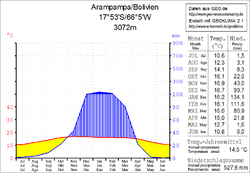Izata
| Izata | ||
|---|---|---|
| Basic data | ||
| Residents (state) | 121 pop. (2012 census) | |
| height | 3210 m | |
| Post Code | 03-0401-0200-3001 | |
| Telephone code | (+591) | |
| Coordinates | 17 ° 45 ′ S , 66 ° 4 ′ W | |
|
|
||
| politics | ||
| Department | Cochabamba | |
| province | Esteban Arce Province | |
| climate | ||
 Climate diagram Arampampa |
||
Izata is a town in the department of Cochabamba in the South American Andean state of Bolivia .
Location in the vicinity
Izata is the central place of the canton of Izata in the district ( Bolivian : Municipio ) Tarata in the province of Esteban Arce . The village is located at an altitude of 3210 m between the valley of the Río Caine in the south-west and the fertile plateau of the Valle Alto of Cochabamba in the north.
geography
Izata is located in the Bolivian Cordillera Central in the transition area to the Bolivian lowlands. The region's climate is typical of the time of day , with the mean temperature fluctuation during the day being more pronounced than during the seasons.
The mean average temperature of the region is around 14 to 15 ° C (see climate diagram Arampampa) and fluctuates only slightly between just under 11 ° C in June and July and just under 17 ° C in November and December. The annual precipitation is a good 500 mm and has a pronounced dry season from April to October with monthly precipitation of 0 to 20 mm, only in the short humid period from January to February 100 to 140 mm monthly precipitation.
Transport network
Izata is located 60 kilometers south of the city of Cochabamba , the capital of the department, in terms of traffic .
From Izata, a road connection leads seventeen kilometers in a south-westerly direction to the mouth of the Río Chincari in the deeply cut valley of the Río Caine, which flows here in a south-easterly direction into the Bolivian lowlands, and from there for a further fifteen kilometers to the village of Arampampa in the north-east. Corner of the Potosí department . To the north, Izata is connected to the national transport network and the plain of Cochabamba via the city of Tarata .
population
The population of the village has increased slightly in the past two decades:
| year | Residents | source |
|---|---|---|
| 1992 | 109 | census |
| 2001 | 161 | census |
| 2010 | 121 | census |
Due to the historically grown population distribution, the region has a high proportion of Quechua population, in the municipality of Tarata 91.7 percent of the population speak the Quechua language.
Individual evidence
- ↑ INE - Instituto Nacional de Estadística Bolivia 1992 ( Memento of the original from April 23, 2014 in the Internet Archive ) Info: The archive link was inserted automatically and has not yet been checked. Please check the original and archive link according to the instructions and then remove this notice.
- ↑ INE - Instituto Nacional de Estadística Bolivia 2001 ( Memento of the original dated December 16, 2015 in the Internet Archive ) Info: The archive link was automatically inserted and not yet checked. Please check the original and archive link according to the instructions and then remove this notice.
- ↑ INE - Instituto Nacional de Estadística Bolivia 2012 ( Memento of the original from July 22, 2011 in the Internet Archive ) Info: The archive link has been inserted automatically and has not yet been checked. Please check the original and archive link according to the instructions and then remove this notice.
- ↑ INE social data Cochabamba 2001 ( Memento of the original from November 13, 2010 in the Internet Archive ) Info: The archive link was inserted automatically and has not yet been checked. Please check the original and archive link according to the instructions and then remove this notice. (PDF; 8.0 MB)
Web links
- Relief map of the Cochabamba region 1: 250,000 (PDF; 10.6 MB)
- Municipio Tarata - detailed map and population data (PDF; 318 kB) (Spanish)
- Municipio Tarata - General Maps No. 30401
- Department of Cochabamba - Social data ( Spanish ) (PDF; 7.58 MB)
